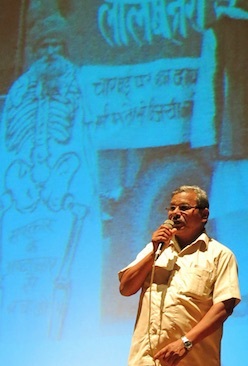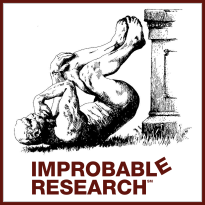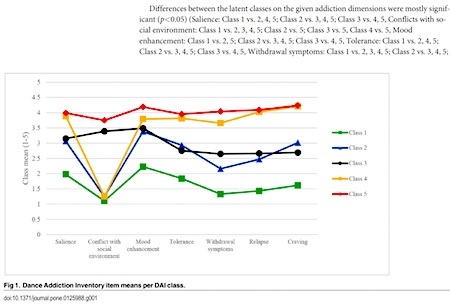Marc Abrahams's Blog, page 330
May 13, 2015
Podcast #11: The Knight of the Living Dead
The Association of Dead People figures heavily in this week’s Improbable Research podcast.
LISTEN on Play.it or iTunes (or DOWNLOAD it, and listen later).
SUBSCRIBE on Play.it or iTunes, to get a new episode every week, free.
This week, Marc Abrahams tells about:

Lal Bihari (photo by Kees Moeliker).
The Knight of the Living Dead. (The Association of Dead People / Lal Bihari / court document / a parade of the dead / CORRECTION: in the podcast, we mis-identify the category of Mr. Bihari’s Ig Nobel Prize — he was in fact awarded the 2003 Ig Nobel PEACE Prize / Lal Bihari meets fellow Ig Nobel Prize winners / “High Court Rescues ‘Living Dead’ of Azamgarh,” Indian Express, July 25, 1999./ “Back to Life in India, Without Reincarnation,” New York Times, October 24, 2000. / “Mritak Sangh And Lal Bihari,” The Financial Express, January 7, 2003.) Here’s video of Lal Bihari:
Boys Will Be Boys. (“Penile Incarceration Secondary to an S-shaped Lead Pipe: Removal with Dremel Moto-Tool,” Sangeeta Lamba, Nitin N. Patel, and Sandra R. Scott, Journal of Emergency Medicine, vol. 42, no. 6 (2012): 659-661. / “Removal of a Long PVC Pipe Strangulated in the Penis by Hot-melt Method,” Ji Jiatao, Xu Bin, Ye Huamao, Hou Jianguo, Liu Bing and Sun Yinghao, Journal of Sexual Medicine, 8, no. 2 (2011): 627-630. Featuring dramatic readings by Jean Berko Gleason.)
Missing Pieces Research Review. (“Social Perceptions of Individuals Missing Upper Front Teeth,” Mary S. Willis, Cynthia Willis-Esqueda, and Ryan N. Schacht, Perceptual and Motor Skills, vol. 106, no. 2, April 2008, pp. 423–35. / “The Effect of Broken Exhibits on the Experiences of Visitors at a Science Museum,” Elizabeth Kunz Kollmann, Visitor Studies, vol. 10, no. 2, October 2007, pp. 178–91. / “The Missing Bones of Thersites: A Note on Iliad 2.212-19,” R. Clinton Simms, American Journal of Philology, vol. 126, no. 1, Spring 2005, pp. 33–40. / “The Mystery of the Missing Toes: Extreme Levels of Natural Mutilation in Island Lizard Populations,” Bart Vervust, Stefan Van Dongen, Irena Grbac, and Raoul Van Damme. Functional Ecology, vol. 23, no. 5, October 2009, pp. 996–1003. / “Automated Solutions to Incomplete Jigsaw Puzzles,” Robert Tybon and Don Kerr, Artificial Intelligence Review, vol. 32, nos. 1–4, 2009, pp. 77–99. Featuring dramatic readings by Richard Baguley.)
Soft Is Hard. (“Mere Exposure to Bad Art,” Aaron Meskin, Mark Phelan, Margaret Moore, and Matthew Kieran, British Journal of Aesthetics, vol. 53, no. 2, 2013, pp. 139–64. / “Do Financial Experts Make Better Investment Decisions?” Andriy Bodnaruka and Andrei Simonov, Journal of Financial Intermediation, epub October 5, 2014. / “The Value of a Smile: Game Theory with a Human Face,” J.P. Scharlemann, C.C. Eckel, A. Kacelnik, and R.K. Wilson, Journal of Economic Psychology, vol. 22, no. 5, 2001, pp. 617–40. / “Identifying a Reliable Boredom Induction,” Amanda Markey, Alycia Chin, Eric M. Vanepps, and George Loewenstein, Perceptual and Motor Skills, vol. 119, no. 1, 2014, pp. 237–53. / “The Fallacy of Personal Validation: A Classroom Demonstration of Gullibility,” Bertram R. Forer, Journal of Abnormal and Social Psychology, vol. 44, no. 1, January 1949, pp. 118–23. Featuring dramatic readings by Jean Berko Gleason.)
The mysterious John Schedler perhaps did the sound engineering this week.
The podcast is all about research that makes people LAUGH, then THINK — real research, about anything and everything, from everywhere —research that may be good or bad, important or trivial, valuable or worthless. CBS distributes it, both on the new CBS Play.it web site, and on iTunes.

Male-Body-Part-Metaphors-driven Organizational Change
If, from a critical and/or strategic management perspective, you’ve examined the metaphorical resources provided by specific parts of the male body for thinking [about] masculinity in social and organizational contexts, then, like many others, you may well have concentrated on the phallus. Now, a new paper in the journal Human Relations (March 5, 2015) points out that :
“ […] other parts of the male genitalia can and do act as root metaphors for alternative forms of masculinity. Where the phallic metaphor focuses attention on power and control, the testicular and seminal metaphors highlight aspects of masculinity that are more relational and creative and bring it closer to the feminine.”

 Authors Prof. Stephen Andrew Linstead, BA, MA, MSC, PhD, DLitt, FRSA, FCIPD, FCMI, Professor of Critical Management at the University of York, UK [pictured left] and Dr Garance Marechal, MA (Distinction), MBA, MSc (Distinction), Ph.D (Distinction), Lecturer in Strategic Management at the University of Liverpool Management School, UK [pictured right] elaborate in their paper ‘Re-reading masculine organization: Phallic, testicular and seminal metaphors’. They explain for example, that Testicular Organizational Manifestation can appear in three forms :
Authors Prof. Stephen Andrew Linstead, BA, MA, MSC, PhD, DLitt, FRSA, FCIPD, FCMI, Professor of Critical Management at the University of York, UK [pictured left] and Dr Garance Marechal, MA (Distinction), MBA, MSc (Distinction), Ph.D (Distinction), Lecturer in Strategic Management at the University of Liverpool Management School, UK [pictured right] elaborate in their paper ‘Re-reading masculine organization: Phallic, testicular and seminal metaphors’. They explain for example, that Testicular Organizational Manifestation can appear in three forms :
Supportive affiliation
Classic coaching behaviour, developing a capacity in others to ‘have the balls’ to assert oneself. Supportive of initiative and develops individuality with collaborative limits. Endurance, protectiveness, passive listening, receptiveness, nurturing over time, ‘stickability’, continuity. Error is corrigible. May degenerate into mere clubbiness, which leads to an easy consensus in decision making.
Competitive affiliation
Team is a collection of individuals – works together to compete against external groups or threats, but a high degree of internal competition and rivalry can produce short-term destructive behaviour, cheating, ostensive display, and risk taking. Error comes to be seen as weakness, as in letting the side down. Can become addictive.
And, in its excessive / inverted form (Testeria)
The feeling you get when you try your best but you don’t make the team or don’t fit in. Feelings of abjection, being vanquished, unworthiness, depressive, obstructive, stubborn, expresses hopelessness and helplessness. No confidence to initiate new activity, withdraws from belief inexisting activity. May convert passive aggression to active opposition to the culture.
Also see: The Testicular Fortitude of Urbexers
Note: According to the online multiple dictionary lookup facility OneLook.com the word “inexisting” doesn’t exist. It does now.

May 12, 2015
Cybersecurity and the Artificial Pancreas
“Cybersecurity and the Artificial Pancreas ” appears to be the subject of this week’s Press Release of the Week. The press release, issued by the Mary-Ann-Liebert-centric entity that calls itself “Mary Ann Liebert, Inc., Publishers”, has been reprinted in several places as a news article. It begins:
Cybersecurity and the Artificial Pancreas—What are the Risks?
New Rochelle, NY, May 12, 2015—An artificial pancreas, designed for blood glucose control in diabetes, is controlled by software that runs on mobile computing platforms such as laptops, tablets, and smartphones, and operates over wireless networks under local or remote medical supervision. As optimal function is critical to an individual’s health, safety, and privacy, the risk of security threats targeting an artificial pancreas is of paramount concern and has not been sufficiently considered in the research and development of these emerging medical devices, according to a Perspective article published in Diabetes Technology & Therapeutics (DTT), a peer-reviewed journal from Mary Ann Liebert, Inc., publishers….
The press release touts this study:
“Cybersecurity in Artificial Pancreas Experiments,” Derek T. O’Keeffe, MB, BCh, BAO, BEng, MEng, PhD, Spyridoula Maraka, MD, Ananda Basu, MD, Patrick Keith-Hynes, PhD, and Yogish C. Kudva, MD., Diabetes Technology and Therapeutics, Volume 17, Number 8, 2015. The authors are at the Mayo Clinic, Rochester, Minnesota, and at the University of Virginia, Charlottesville, Virginia.
(Thanks to Ivan Oransky for bringing this to our attention.)
BONUS: More about Mary Ann Liebert [pictured above]

Physics of Low Pressure Popcorn Popping
There’s news, though a few years old, about low-pressure popcorn popping:
“The Effects of Popping Popcorn Under Reduced Pressure,” Paul Quinn [pictured here] and Amanda Cooper, Bulletin of the American Physical Society, Volume 53, Number 2 (poster at the 2008 APS March Meeting, New Orleans, Louisiana). The authors, at Kutztown University, report:
“In our experiments, we model the popping of popcorn as an adiabatic process and develop a process for improving the efficiency of popcorn production. By lowering the pressure of the popcorn during the popping process, we induce an increase in popcorn size, while decreasing the number of remaining unpopped kernels. In this project we run numerous experiments using three of the most common popping devices, a movie popcorn maker, a stove pot, and a microwave. We specifically examine the effects of varying the pressure on total sample size, flake size and waste. An empirical relationship is found between these variables and the pressure.”
That’s not the end of the story. For the next chapter, read “From popcorn to the patent office.” It begins by saying:
How did the popcorn get to the patent office? It started out as part of an undergraduate research project to explore what physical parameters were related to the efficiency of the popping process. However, when the experiments were more successful than expected, the professor and his students decided to see if they had developed something patentable….
NOTE: The researchers apparently have no connection with the entity called Quinn Popcorn.

A Spanish TV peek at some Ig Nobel Prizes
TV3, in Spain, took this look (“IgNobel, riure amb la ciència”) at a few Ig Nobel Prize-winning achievements, and at a few other things:

May 11, 2015
WHO says: No who, no where
Innocuity is now a recommended goal in naming a disease. “” is the headline on a report by Kai Kupferschmidt, in ScienceInsider. It says, in part:
The World Health Organization (WHO) mostly works to reduce the physical toll of disease. But last week it turned to another kind of harm: the insult and stigma inflicted by diseases named for people, places, and animals….
Many scientists agree that disease names can be problematic, but they aren’t sure the new rulebook is necessarily an improvement. “It will certainly lead to boring names and a lot of confusion,” predicts Linfa Wang [pictured here], an expert on emerging infectious diseases at the Australian Animal Health Laboratory in Geelong….
Giving new diseases a number may be the only way to avoid such issues, researchers say. There is precedent. Growing up in China in the late 1960s, Wang remembers that diseases had digits. “I was really scared of number 5 disease,” he recalls. “I don’t know why, you just really did not want to get disease number 5.”
BONUS (quasi-related): Firesign Theatre’s “Beat the Reaper“

An empirical investigation of dance addiction
Dancing is mentally dangerous, suggests this new study, which is a further advance in our understanding the threats posed by addiction:
“An Empirical Investigation of Dance Addiction,” Aniko Maraz [pictured here], Róbert Urbán, Mark Damian Griffiths, Zsolt Demetrovics, PLoS ONE 10(5), May 7, 2015, e0125988. (Thanks to Neil Martin for bringing this to our attention.) The authors, at Eötvös Loránd University, Budapest, Hungary, and at Nottingham Trent University, UK, explain:
Little is known about the harmful effects of excessive dancing. The aim of the present study was to explore the psychopathological factors associated with dance addiction. The sample comprised 447 salsa and ballroom dancers (68% female, mean age: 32.8 years) who danced recreationally at least once a week. The Exercise Addiction Inventory (Terry, Szabo, & Griffiths, 2004) was adapted for dance (Dance Addiction Inventory, DAI)…. DAI was positively associated with psychiatric distress, borderline personality and eating disorder symptoms…. Dance addiction as assessed with the Dance Addiction Inventory is associated with indicators of mild psychopathology and therefore warrants further research.
Co-author Mark Griffiths is noted for his ongoing relation to addiction and gambling.
Here’s further detail from the dancing addiction study — a graph that clearly indicates the production of data:
BONUS: An earlier, less academically turgid investigation of dancing addiction — a 1987 film called “Dirty Dancing”:

Partially drunk people can appear more attractive
There’s yet another twist in research news about drunkenness and the perception of beauty.
The 2013 Ig Nobel psychology prize was awarded to Laurent Bègue [FRANCE], Brad Bushman [USA, UK, the NETHERLANDS, POLAND], Oulmann Zerhouni [FRANCE], Baptiste Subra [FRANCE], and Medhi Ourabah [FRANCE], for confirming, by experiment, that people who think they are drunk also think they are attractive. (See: “‘Beauty Is in the Eye of the Beer Holder': People Who Think They Are Drunk Also Think They Are Attractive,” British Journal of Psychology, epub May 15, 2012.)
Now, new research has identified a related phenomenon, a twist which could perhaps be described as ‘The Complementary Inverse Beer Goggles Effect’. A research team led by Professor Marcus Munafò MA(Oxon), MSc, PhD(Soton) who is Professor of Biological Psychology at the School of Experimental Psychology, University of Bristol, UK, have attempted to find out whether drunken people might be rated as more attractive by others who are completely sober.
Their experimental research project discovered that although somewhat drunk people can indeed appear more attractive to others, the effect quite rapidly falls off if they drink much more. For those who wish to conduct their own research, note that the optimal dose for one to look one’s most attractive was found to be around 250 ml of wine (at 14% alcohol). See: Increased Facial Attractiveness Following Moderate, but not High, Alcohol Consumption (forthcoming in Alcohol and Alcoholism) Before embarking on any practical applications however, you might also want to check this 2012 paper: ‘The imbibing idiot bias: Consuming alcohol can be hazardous to your (perceived) intelligence’
Also see: How many drinks does it take you to feel drunk?

May 10, 2015
Cleanliness at the gym leads to dirty doings, they say
Dire doings at the gym, after cleansing. Ditto at the religious bath. So says this study:
“Being Clean and Acting Dirty: The Paradoxical Effect of Self-Cleansing,” Thalma E. Lobel [pictured here], Allon Cohen, Lior Kalay Shahin, Shimon Malov, Yaniv Golan and Shani Busnach, Ethics and Behavior, epub June 27, 2014. (Thanks to Neil Martin for bringing this to our attention.) The authors, at Tel-Aviv University, Israel, explain:
“In two studies we investigated the association between physical cleansing and moral and immoral behavior in real-life situations. In Study 1, after a workout at the gym, participants cheated more after taking a shower than before taking one. In the second study participants donated more money to charity before rather than after they bathed for religious purification.”

May 9, 2015
The Chimpanzee Who Became a Gorilla
Humans who study animals sometimes quarrel about exactly what they are seeing. The ape Mafuka was the subject of one such quarrel:
“Watching Exotic Animals Next Door: ‘Scientific’ Observations at the Zoo (ca. 1870–1910),” Oliver Hochadel, Science in Context, vol. 24, no. 2, 2011, pp. 183–214. The author, at Institucio Mila i Fontanals, CSIC, Barcelona, explains:
“In the summer of 1875, the ape Mafuka, a main attraction at the Dresden Zoological Gardens, became an international sensation. While she had been considered a chimpanzee from the time she arrived two years earlier, some of her visitors now claimed that she was in fact a gorilla, a creature that no European except a few explorers had ever seen alive. Since the first description of this curious animal in 1847, all attempts to bring a living specimen to a zoo had failed, hence the excitement and also the national pride expressed in the German media. Yet the recategorization was disputed and the debate about Mafuka’s species continued until after her death in December 1875.”

Marc Abrahams's Blog
- Marc Abrahams's profile
- 14 followers





